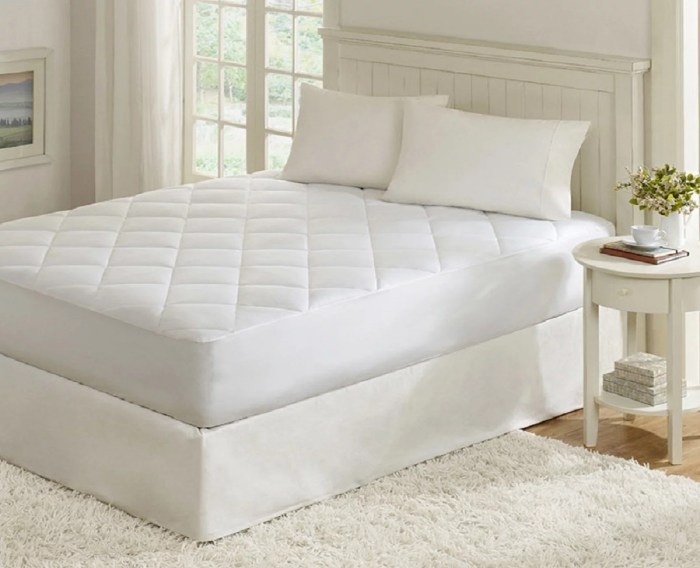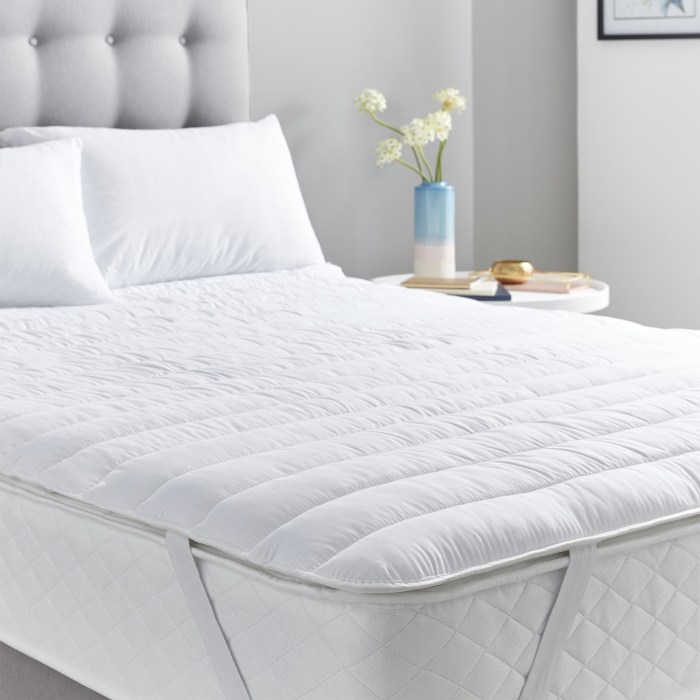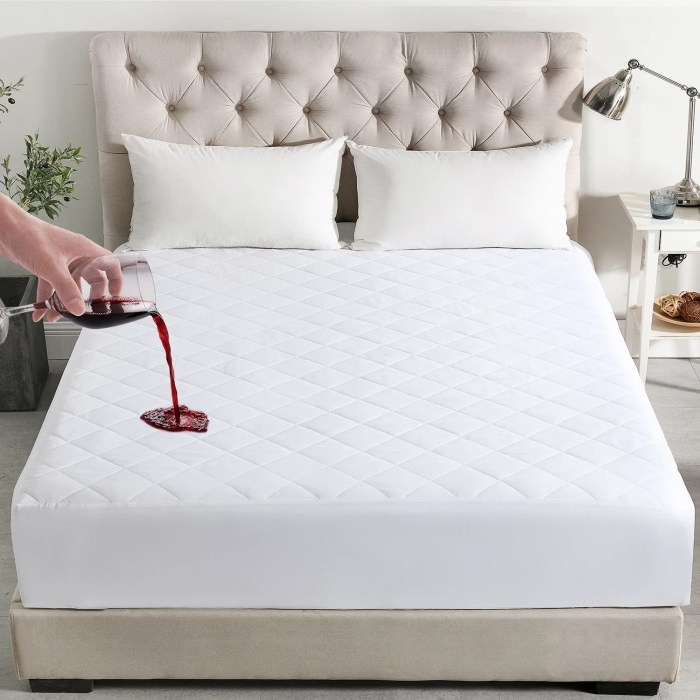Mattress protectors are an essential component of any bedding ensemble, providing a protective layer against spills, stains, and allergens. Whether you’re seeking comfort, longevity, or hygiene, a mattress protector can cater to your needs.
This guide will delve into the different materials, types, benefits, and maintenance tips for mattress protectors, empowering you to make an informed decision that ensures a restful and rejuvenating sleep experience.
Mattress Protector Materials and Features

Mattress protectors are available in a variety of materials, each with its own unique set of features and benefits. The most common materials used in mattress protectors include cotton, bamboo, and synthetic fibers.
Cottonis a natural fiber that is soft, breathable, and absorbent. Cotton mattress protectors are a good choice for people who want a comfortable and hypoallergenic option. However, cotton is not as durable as some other materials, and it can wrinkle easily.
Bamboois a sustainable material that is soft, breathable, and moisture-wicking. Bamboo mattress protectors are a good choice for people who want a comfortable and eco-friendly option. Bamboo is also more durable than cotton, and it does not wrinkle as easily.
Synthetic fibers, such as polyester and nylon, are durable, wrinkle-resistant, and moisture-wicking. Synthetic mattress protectors are a good choice for people who want a low-maintenance option. However, synthetic fibers are not as breathable as natural fibers, and they can trap heat.
Comparison of Mattress Protector Materials
The following table compares the key features and benefits of different mattress protector materials:| Material | Softness | Breathability | Absorbency | Durability | Wrinkle Resistance | Moisture-Wicking | Hypoallergenic | Eco-Friendly ||—|—|—|—|—|—|—|—|—|| Cotton | Soft | Breathable | Absorbent | Low | Low | Low | Yes | Yes || Bamboo | Soft | Breathable | Moisture-wicking | Medium | Medium | Medium | Yes | Yes || Synthetic fibers | Firm | Low | Moisture-wicking | High | High | High | No | No |
Investing in a high-quality mattress protector is crucial for preserving your precious mattress. But don’t overlook the importance of ambient lighting in your bedroom. A stylish floor lamp can elevate the ambiance and create a relaxing atmosphere. By casting a warm glow, it can help you unwind before bed.
And when it’s time to drift off to sleep, simply switch off the lamp and snuggle into the comfort of your mattress, knowing that it’s well-protected and ready to provide a restful night’s sleep.
Types of Mattress Protectors

Mattress protectors come in various types, each designed to serve specific needs and preferences. Understanding the different types can help you choose the most suitable option for your mattress.
The three main types of mattress protectors are fitted, flat, and encasement protectors. Each type offers unique advantages and is ideal for different scenarios.
Fitted Mattress Protectors
- Fitted mattress protectors are designed with elastic edges that stretch and fit snugly over the mattress, much like a fitted sheet.
- They provide a secure and comfortable fit, preventing shifting or bunching.
- Fitted protectors are ideal for regular use and can be easily removed for washing.
Flat Mattress Protectors
- Flat mattress protectors are rectangular pieces of fabric that are placed on top of the mattress.
- They do not have elastic edges and are held in place by the weight of the mattress and bedding.
- Flat protectors offer basic protection against spills and stains but may not stay in place as well as fitted protectors.
Encasement Mattress Protectors
- Encasement mattress protectors fully enclose the mattress, providing comprehensive protection from spills, stains, dust mites, and allergens.
- They are typically made of waterproof and breathable materials, ensuring a comfortable sleeping environment.
- Encasement protectors are ideal for people with allergies, asthma, or incontinence.
Benefits of Using Mattress Protectors
Mattress protectors offer numerous advantages that enhance the quality and longevity of your mattress. By providing a protective barrier, they safeguard against various hazards that can damage or compromise its integrity.
Protection from Spills and Stains, Mattress protector
Mattress protectors serve as an effective shield against accidental spills and stains. Liquids, such as coffee, juice, or bodily fluids, are prevented from seeping into the mattress, minimizing the risk of permanent discoloration or damage. This is especially crucial for families with young children or pets, who may be more prone to spills.
Mattress protectors safeguard your mattress from spills, stains, and dust mites, ensuring a hygienic and comfortable sleep. For those who prefer the firm support of sleeping directly on the floor, a sleeping mattress on floor can provide the necessary comfort and protection.
Consider using a mattress protector specifically designed for floor mattresses to extend its lifespan and maintain its pristine condition.
Prevention of Allergens and Dust Mites
Mattress protectors can significantly reduce the accumulation of allergens and dust mites, which can trigger allergies, asthma, or other respiratory issues. By creating a physical barrier, they trap these allergens and prevent them from entering the mattress, creating a cleaner and healthier sleep environment.
Extension of Mattress Lifespan
By protecting the mattress from spills, stains, and allergens, mattress protectors extend its lifespan by minimizing wear and tear. The mattress remains clean and fresh, reducing the need for frequent deep cleaning or replacement, ultimately saving you time and money.
A mattress protector is a must-have for any bed, and it’s especially important for japanese futon . Futons are delicate and can easily be damaged by spills or stains, so a mattress protector will help to keep them looking their best.
Mattress protectors are also great for protecting your mattress from dust mites and other allergens, which can help to improve your sleep quality.
Improved Sleep Quality
A clean and protected mattress contributes to improved sleep quality. Free from allergens, dust mites, and stains, it creates a more hygienic and comfortable sleeping environment, promoting restful and rejuvenating sleep.
Choosing the Right Mattress Protector

Selecting the ideal mattress protector involves understanding your specific requirements and preferences. Consider the following factors:
Mattress Size
Measure your mattress accurately to determine the correct protector size. A snug fit ensures optimal protection and prevents shifting or bunching.
Material
Choose a material that aligns with your comfort and protection needs. Options include:
- Cotton:Breathable and soft, providing comfort and moisture absorption.
- Waterproof:Blocks spills and accidents, protecting your mattress from liquids.
- Allergies:Hypoallergenic materials minimize dust mite and allergen exposure.
- Cooling:Gel-infused or moisture-wicking materials regulate temperature for a cooler sleep.
Desired Level of Protection
Consider the level of protection you need:
- Basic:Provides general protection from dust and dirt.
- Waterproof:Essential for spill protection and those with incontinence issues.
- Allergy-Blocking:Ideal for those with allergies or sensitive skin.
- Encasement:Encloses the entire mattress, providing maximum protection from bed bugs and allergens.
Care and Maintenance of Mattress Protectors
To ensure optimal performance and longevity of your mattress protector, proper care and maintenance are crucial. This involves regular washing, careful handling, and appropriate storage.
Washing Instructions
- Frequency: Mattress protectors should be washed regularly, ideally every 2-3 months. However, if you have allergies or experience heavy sweating, more frequent washing may be necessary.
- Water Temperature: Use warm or cold water for washing. Avoid using hot water, as it can damage the fabric and reduce the protector’s effectiveness.
- Detergent: Use a mild detergent specifically designed for delicate fabrics. Avoid using harsh detergents or bleach, as these can weaken the fibers.
- Wash Cycle: Select a gentle wash cycle with a low spin speed. Avoid using the “sanitize” or “extra spin” settings, as these can be too aggressive for the fabric.
Drying Instructions
- Tumble Dry: Tumble dry on low heat or air dry. Avoid over-drying, as it can shrink or damage the protector.
- Hang Dry: If possible, hang dry the mattress protector in a well-ventilated area. This helps prevent wrinkles and preserves the fabric’s integrity.
Storage Tips
- Clean and Dry: Before storing, ensure the mattress protector is clean and completely dry. Moisture can lead to mold or mildew growth.
- Fold or Roll: Fold or roll the mattress protector neatly to minimize wrinkles and creases. Avoid stuffing it into a small space, as this can damage the fabric.
- Store in a Cool, Dry Place: Store the mattress protector in a cool, dry place, away from direct sunlight and moisture.
Conclusion: Mattress Protector
In conclusion, mattress protectors are indispensable for maintaining the hygiene, longevity, and comfort of your mattress. By choosing the right protector and following proper care instructions, you can extend the life of your mattress, safeguard it from everyday wear and tear, and create a more restful and inviting sleep environment.
FAQ Overview
How often should I wash my mattress protector?
It is recommended to wash your mattress protector every 2-3 months or more frequently if you have pets or allergies.
Can I use a mattress protector on an adjustable bed?
Yes, there are mattress protectors specifically designed for adjustable beds that can accommodate the movement of the base.
What is the best material for a mattress protector?
The best material for a mattress protector depends on your individual needs and preferences. Cotton is a natural and breathable option, while synthetic materials like polyester provide a waterproof barrier.